Science
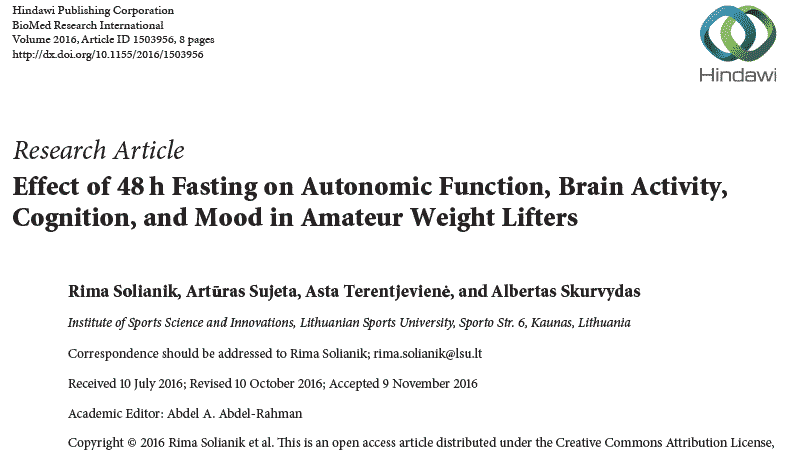
Effects of Fasting on Cognitive, Emotional Functioning and Autonomic Nervous System
In this clinical trial, Dr.Solianik and colleagues1 explore the effects of 48-hour fast on cognitive and emotional status of a group of 9 young healthy amateur weightlifters as well as some changes in their autonomic nervous system regulation. The subjects received a 48-hour zero-calorie diet and authors observed decreases in weight, heart rate and blood pressure.
In terms of cognitive and emotional functioning, they noted that fasting has affected mental flexibility and shifting set, but there were no changes in memory, spatial orientation, and visuospatial discrimination. Also, they have noted that the subjects experienced statistically significant increase in anger as well as statistically non-significant decrease in vigor and increases in fatigue, depression and confusion, which in my opinion offset the positive cognitive findings to a large extent.
I highly recommend exploring this article as it provides a great scientific snapshot of the effects of a real fast on our cognitive performance and emotional states. The authors’ findings also correspond with my own experiment with fasting.
Link: https://pubmed.ncbi.nlm.nih.gov/28025637/
Reference:
1. Solianik R, Sujeta A, Terentjevienė A, Skurvydas A. Effect of 48 h Fasting on Autonomic Function, Brain Activity, Cognition, and Mood in Amateur Weight Lifters. BioMed Research International. 2016;2016:1-8. doi:10.1155/2016/1503956
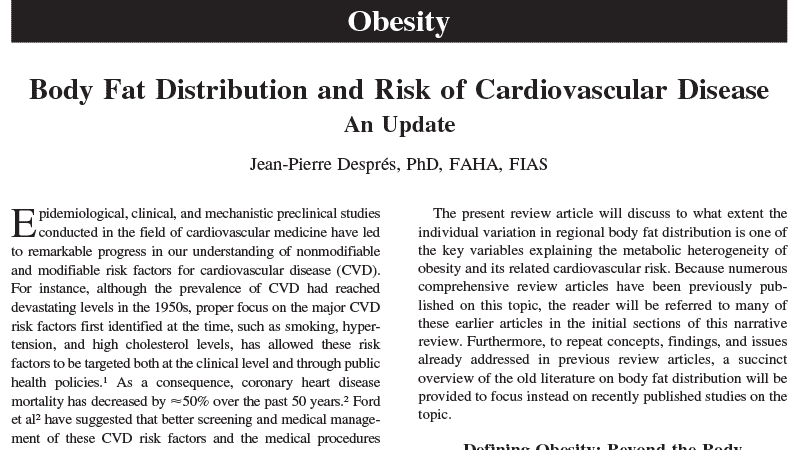
Body Fat Distribution and Risk of Cardiovascular Disease
In this article, Dr.Després1 explores the dimensions of the impact of obesity on cardiovascular disease – specifically, he focuses on the J-shaped curvilinear relationship between excessive body mass as measured by BMI and the risk of adverse cardiac events.
It is well known that obesity is a major risk factor for heart disease and many other ailments, but we also know that people with technically the same level of adiposity or BMI can be at a significantly different risk of developing heart disease as they may have different fat distribution profiles. He points out that visceral fat is one of the major contributors to cardiovascular morbidity as well as the ectopic fat depositions in the liver and epicardial-pericardial area, which are not mentioned in scientific literature often enough.
This is a great contribution that is well in line with my philosophy on BMI and weight loss. I highly recommend reading it as it is well-written and well-resourced.
Link: https://pubmed.ncbi.nlm.nih.gov/22949540/
Reference:
1. Després JP. Body fat distribution and risk of cardiovascular disease: an update. Circulation. Sep 4 2012;126(10):1301-13. doi:10.1161/circulationaha.111.067264

The Santa Clara COVID-19 Seropositivity Study
Dr.Ioannidis announced a new “breakthrough” research study1 that aimed to estimate the real number of people infected with coronavirus. The study attracted a lot of attention for obvious reasons and I believe that it must be communicated to the public, but it must be done properly and without sensationalism.
The authors have advertised their study via Facebook ads, which attracted 3,330 individuals. They tested them using lateral flow immunoassay and reported the unadjusted prevalence of antibodies of 1.5% and the population-based prevalence of 2.81%. They interpreted these results as an indication that there are 50-85 times more people infected with coronavirus in general population and accordingly the virus has spread much wider that we expected and its case fatality rate is much lower, around the same level as the regular flu.
While it corroborates my message on real statistics of the COVID-19, I must say that the study appears to be heavily flawed and cannot be extrapolated to the whole population. I will talk about it in my blog and on my YouTube channel.
Link: https://www.medrxiv.org/content/10.1101/2020.04.14.20062463v1
Reference:
1. Bendavid E, Mulaney B, Sood N, et al. COVID-19 Antibody Seroprevalence in Santa Clara County, California. medRxiv. 2020:2020.2004.2014.20062463.

Early testing for COVID-19 in Iceland
With the ongoing pandemic each piece of information matters. I started my COVID-19 series and this article1 is one of the early publications on the subject, which comes from a country that appears to be managing this pandemic quite well.
They have tested 3 cohorts of patients and obtained the following results:
- Targeted testing of those who were exposed or were at high risk of COVID-19. The highest percentage of confirmed cases predictably – 13.3%.
- Open invitation from the general population: 0.8%
- Randomly invited subjects: 0.6%
These data should be, of course interpreted in the context of the prevalence of the COVID-19 cases at that moment of time. The study was completed as of April 4th, 2020. We know that there were ~1,400 confirmed cases at that time for the country with a population of ~364,000, which gives us an estimate of COVID-19 prevalence of 0.38%. The prevalence of positives in the random invitation sample was higher – 0.6% and in the open invitation sample it was even higher – 0.8%. Needless to say, the targeted sampling yielded disproportionately high percentage of cases. Of note, 43% of those who tested positive were asymptomatic at the time of testing. Also, it must be noted that the sampling method was not random and thus there is a risk of bias and significant distortion of data.
Nevertheless, I believe that this study is of high quality and the authors are aware and acknowledging its limitations.
Link: https://www.nejm.org/doi/pdf/10.1056/NEJMoa2006100?listPDF=true
Reference:
1. Gudbjartsson DF, Helgason A, Jonsson H, et al. Spread of SARS-CoV-2 in the Icelandic Population. New England Journal of Medicine. 2020.

Obesity Energetics
This an absolutely beautiful paper1 thoughtfully reviewing the existing evidence on the interplay between nutrient intake, physical exercise and weight loss regulation. The authors integrate the state-of-the-art evidence in a logical and persuasive way and reflect on different models of body weight regulation, responses to exercise and changes due to various nutritional approaches.
As a bonus, authors report the results of a meta-analysis of 32 controlled feeding studies with isocaloric substitution of dietary fats with carbohydrates with a surprising but statistically significant finding of less effective weight loss in subjects on low-carbohydrate diets as compared to those who were receiving low-fat diets.
I believe that this article is a must read as it is as thought-provoking as it is informative.
Link: https://www.ncbi.nlm.nih.gov/pubmed/28193517
Reference:
1. Hall KD, Guo J. Obesity Energetics: Body Weight Regulation and the Effects of Diet Composition. Gastroenterology. 2017;152(7):1718-1727.e1713.
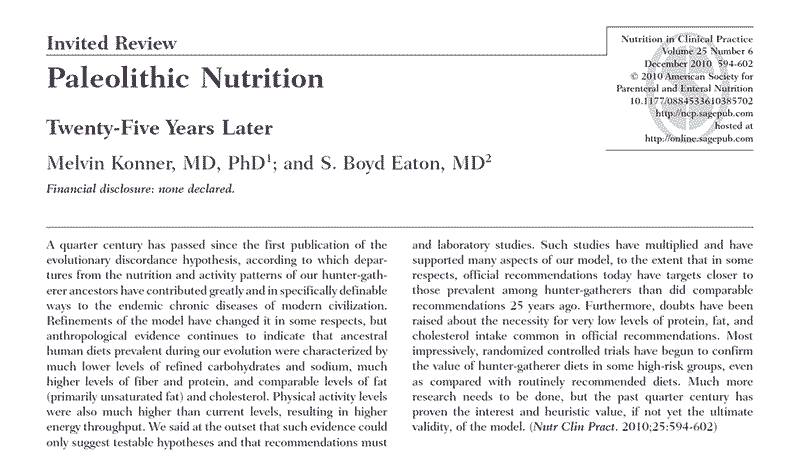
Paleolithic Nutrition: 25 Years Later
This is quite an interesting and unique article – we rarely see authors return to their own published works 25 years since the publication, but Melvin Konner and S. Boyd Eaton did it in 20101.
A lot of changes occurred in our understanding of human nutrition since the publication of their original work2, including the introduction of the Paleo diet, in many aspects due to the efforts of the authors of this article and its predecessor. They review the changes in nutritional recommendations and guidelines in the past quarter century, the refinement of their evolutionary discordance hypothesis and the relevance of the hunter-gatherer diets for our modern society.
I found both articles fascinating and highly recommend reading them. And of course, since I am so adamant about them, I will make videos both on paleolithic nutrition and the Paleo diet in my Diet Review Series.
Link: https://www.ncbi.nlm.nih.gov/pubmed/21139123
Reference:
1. Konner M, Eaton SB. Paleolithic nutrition: twenty-five years later. Nutr Clin Pract. 2010;25(6):594-602.
2. Eaton SB, Konner M. Paleolithic nutrition. A consideration of its nature and current implications. N Engl J Med. 1985;312(5):283-289.

Dietary Fat and Cardiometabolic Health
This is an open-access (please see the link below) review published in the BMJ1. The authors are renown experts in the field and provide an excellent review of the existing and emerging evidence of various types of fats consumed and their effects on our health in the context of the dietary recommendations.
This article takes a critical look at the evolution of the scientific understanding of dietary fats and health, the difficulties of establishing public health dietary guidelines, and what the current advice should be for dietary fat consumption. They review the “Diet-Heart Hypothesis” introduced by Ancel Keys in the early 1950s and the lack of direct evidence supporting it. As an alternative to the simplistic and outdated theories they introduce the concept of “food matrix” effect, which is not captured by investigating single nutrients, and emphasize the necessity to look at all nutrients intake and their multifaceted interactions.
Link: https://www.bmj.com/content/361/bmj.k2139
Reference:
1. Forouhi NG, Krauss RM, Taubes G, Willett W. Dietary fat and cardiometabolic health: evidence, controversies, and consensus for guidance. BMJ. 2018;361:k2139.
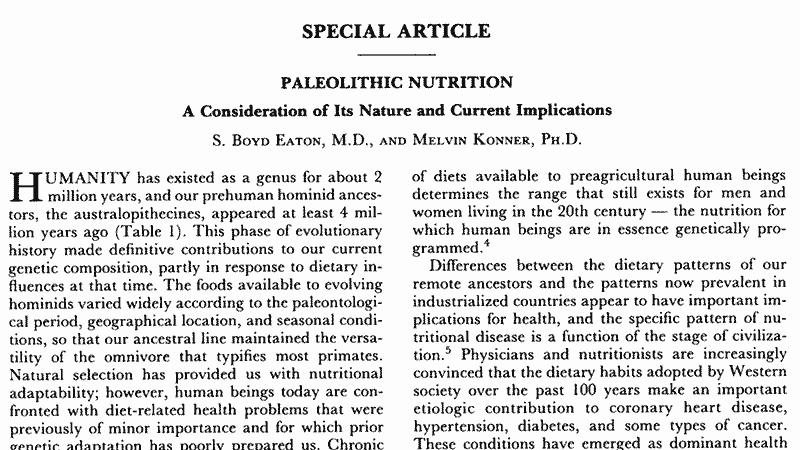
Paleolithic Nutrition
This article is the 1985 classic text by S. Boyd Eaton and Melvin Konner1 comparing the genetic programming of our nutrition to the foods that we are effectively consume nowadays. They talk about the emergence of multiple health issues such as hypertension, diabetes, cancer, coronary heart disease and link these conditions with the changes in our nutrition, specifically with the Western Diet. They also show that while younger individuals in Western society tend to develop these conditions, hunter-gatherer youths do not. Individuals who live to their 60s in technologically primitive societies also tend to be free of these conditions. In order to solve the riddle of optimal nutrition matching our genetics they summarize the anthropological data from modern hunter-gatherer societies and the archeological data from the remains of the paleolithic humans. Of note, S.Boyd Eaton is one of the originators of the Paleo diet concepts, which I will definitely cover later on in my Diet Review Series.
Link: https://pubmed.ncbi.nlm.nih.gov/21139123/
Reference:
1. Eaton SB, Konner M. Paleolithic nutrition. A consideration of its nature and current implications. N Engl J Med. 1985;312(5):283-289.
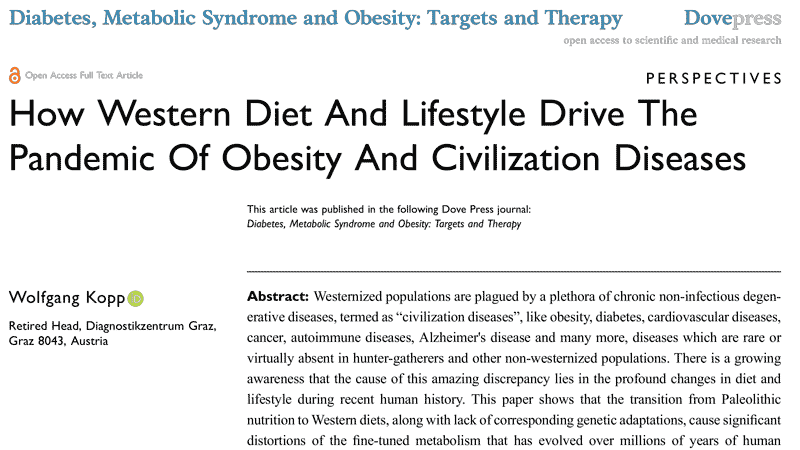
The Western Diet and Lifestyle and Pandemic of Obesity and Civilization Diseases
This article represents a detailed review and comparisons between the paleolithic era hunter-gatherer diet and the modern Western diet1. Author reviews the key differences between these two nutritional patterns and their role in development of various “diseases of civilization”.
Specifically, he covers the macronutrient composition and predominance of carbohydrates in the modern diet, excess of ω-6 polyunsaturated fatty acids, lack of genetic adaptation; the role of the reactive oxygen species, oxidative stress and oxidative phosphorylation as well as the hyperinsulinemia, obesity, hypertension, and chronic inflammation in development of type 2 diabetes, cardiovascular diseases and cancer. He also reviews the lifestyle modification and the gut microbiome as important elements in the multifactorial nature of multiple health issues.
Link: https://www.ncbi.nlm.nih.gov/pubmed/31695465
Reference:
1. Kopp W. How Western Diet And Lifestyle Drive The Pandemic Of Obesity And Civilization Diseases. Diabetes Metab Syndr Obes. 2019;12:2221-2236.

The Western Diet: Review of its Origins, Evolution, Composition and Health Implications
This is a comprehensive review of the Western Diet that covers its origins and evolution, the changes in nutritional patterns in the Western world and their implications for the population health1.
Authors provide and excellent overview of the historical aspects of the Western diet starting with its inception, development of agriculture and animal husbandry and its further evolution in the industrialized era. They discuss the trends in the Western Diet composition and compare the typical nutrient intake to the 2005 Nutritional Guidelines for Americans with the implications of the Western Diet on health and its association with various health issues and diseases such as type 2 diabetes, heart disease, obesity and many others.
Link: https://www.ncbi.nlm.nih.gov/pubmed/15699220
Reference:
1. Cordain L, Eaton SB, Sebastian A, et al. Origins and evolution of the Western diet: health implications for the 21st century. Am J Clin Nutr. 2005;81(2):341-354.

The Standard American Diet: Review of its Composition and Health Effects
This is an excellent up-to-date and concise review of the Standard American Diet1. The article discusses the origins of the Standard American Diet, its composition and the effects of various nutrients on health.
Authors define the Standard American Diet as a total diet pattern that has multicultural variations and is characterised by excess consumption of calories from carbohydrates, fatty meats and lacking several nutrients found in plant-based foods and discuss its contribution to the diet-related diseases such as type 2 diabetes and hypertension. Special attention is paid to the changes in the nutritional patterns in the United States in the past several decades and the effects of these changes on the population health and links to the obesity epidemic.
Link: https://www.ncbi.nlm.nih.gov/pubmed/21139124
Reference:
1. Grotto D, Zied E. The Standard American Diet and its relationship to the health status of Americans. Nutr Clin Pract. 2010;25(6):603-612.
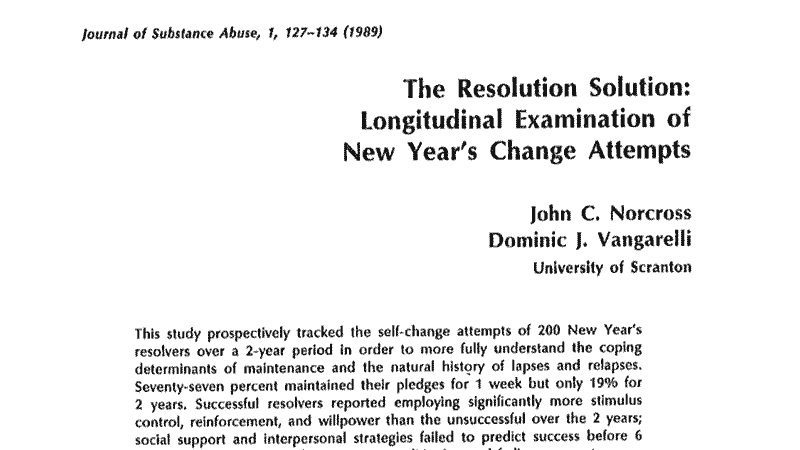
Change Psychology: The Longitudinal Study on the adherence to New Year’s Resolutions
The 2-year follow-up study by Dr.Norcross1 on the New Year’s resolutions. The study added a 2-year follow-up survey of the 200 subjects from his first study on feasibility of New Year’s resolutions.
The main outcome of the original study was that the resolvers were able to adhere to their resolutions in 55%, 43% and 40% of cases at 1-, 3-, and 6-month marks respectively. This study added another time point to that investigation and showed that after 2 years only 19% of resolvers were able to adhere to their resolutions.
While this statistic is not very encouraging, I would invite you to review my comprehensive analysis and interpretation of Dr.Nocross’ team research findings on New Year’s Resolutions in my blog "New Year’s Resolutions: An Update".
Link: https://www.ncbi.nlm.nih.gov/pubmed/2980864
Reference:
1. Norcross JC, Vangarelli DJ. The resolution solution: longitudinal examination of New Year's change attempts. J Subst Abuse. 1988;1(2):127-134.
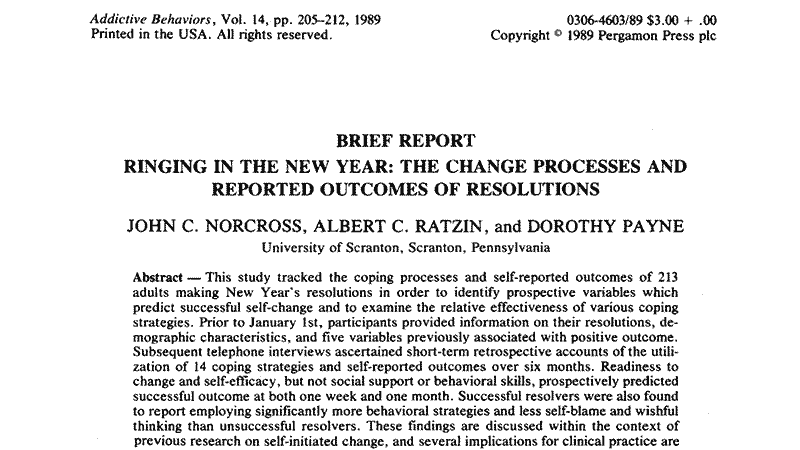
Change Psychology: The New Year’s Resolutions Study (1989)
The first study by Dr.Norcross, published in 19891. The study followed 200 subjects who made New Year’s Resolutions for 6 months and reported on their rate of adherence to their resolutions.
The main outcome of the study was that the resolvers were able to adhere to their resolutions in 55%, 43% and 40% of cases at 1-, 3-, and 6-month marks respectively. The major limitation was the absence of a control group, which was addressed by another study by Dr.Norcross and colleagues, published in 2002. They also conducted a 2-year follow-up study, published separately.
You can see my detailed interpretation of Dr.Nocross’ team research findings on New Year’s Resolutions in my blog "New Year’s Resolutions: An Update".
Link: https://www.ncbi.nlm.nih.gov/pubmed/2728957
Reference:
1. Norcross JC, Ratzin AC, Payne D. Ringing in the new year: the change processes and reported outcomes of resolutions. Addict Behav. 1989;14(2):205-212.
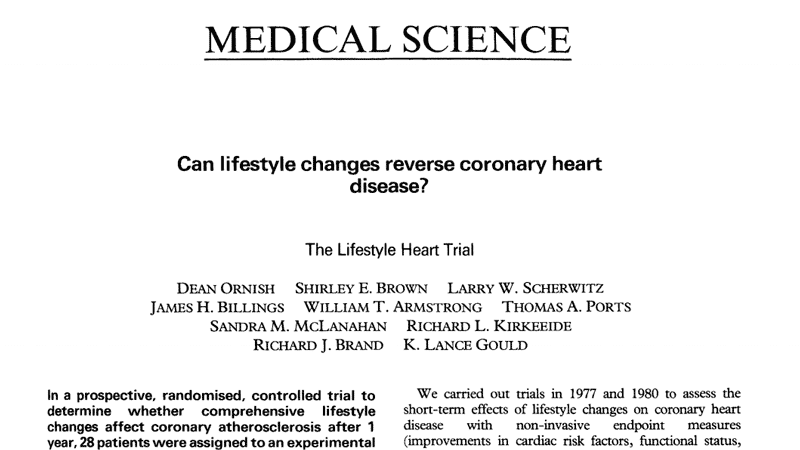
The Lifestyle Heart Trial
This is quite an influential study by Dr.Ornish1. They conducted a clinical trial of a comprehensive behavioral and nutritional intervention in people with severe coronary artery disease. The experimental group (n=28) received a complex intervention, which included low-fat vegetarian diet, stress management, smoking cessation and moderate exercise. The control group (n=20) received treatment as usual.
The study lasted 1 year and by the end of the study the authors reported a decrease in coronary artery stenosis diameter (from 40.0% to 38.7%) in subjects receiving comprehensive intervention whereas some increase is stenosis diameter was observed in the control group. The study was a hit of its time and it still is. What is shows that a comprehensive intervention can reverse the course of a serious heart problem.
Link: https://www.ncbi.nlm.nih.gov/pubmed/1973470
Reference:
1. Ornish D, Brown SE, Scherwitz LW, et al. Can lifestyle changes reverse coronary heart disease? The Lifestyle Heart Trial. Lancet. 1990;336(8708):129-133.

Prevalence of Low-Carbohydrate Diet Use
My colleague and a fellow YouTuber, Dr.Fox, The Lifting Dermatologist, asked me a good question – how many people use low-carbohydrate / ketogenic diets? It turned out that such a simple question was not an easy one to answer.
Here, I would like to present one of the very few studies on prevalence of low-carbohydrate use. The study of Blanck et al1 was published in 2006 and was based on a telephone survey of 9,300 Americans. The authors reported that among their respondents 12.5% reported ever used a low-carbohydrate diet (lifetime prevalence) and 3.4% reported current use (point prevalence), which I think is a good snapshot of the low-carbohydrate diet use. This study is of decent size, but it’s limited to one geographic area and somewhat outdated. That’s the best I have at the moment, but I promise to keep my eyes open and making a follow-up report is I come across something new.
Link: https://www.medscape.org/viewarticle/528758
NB: You would need to register at Medscape (it’s free) to access the actual report.
Reference:
1. Blanck HM, Gillespie C, Serdula MK, Khan LK, Galusk DA, Ainsworth BE. Use of low-carbohydrate, high-protein diets among americans: correlates, duration, and weight loss. MedGenMed : Medscape general medicine. 2006;8(2):5.
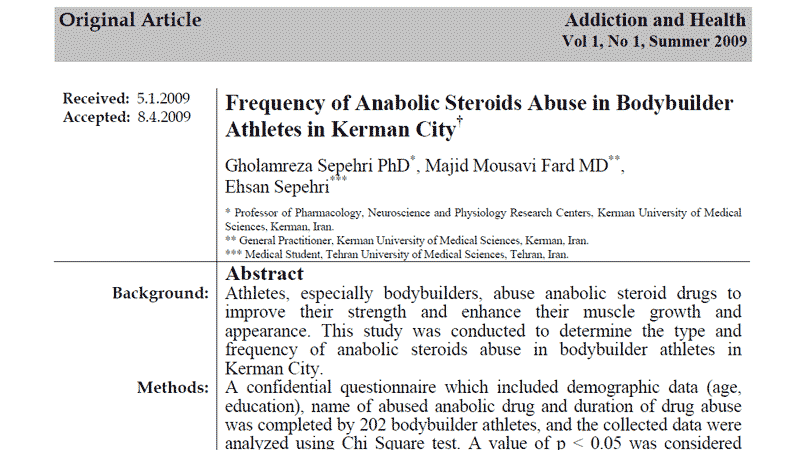
Prevalence of Steroid Use among Athletes
We know that some athletes are using anabolic steroids to boost their athletic performance, but the numbers of actual prevalence of steroid use are hard to come by. Sepehri et al1, conducted a confidential survey of 202 athletes in Kerman city in Iran. They found that 18.8% of the athletes reported steroid use. The study obviously has some limitations as it was based on self-reported data and limited to a specific location, so their findings cannot be generalized. At the same time, it is a relatively recent study and we can use their data to gauge the prevalence of anabolic steroids in other settings.
Link: https://www.ncbi.nlm.nih.gov/pmc/articles/PMC3905495/
Reference:
1. Sepehri G, Mousavi Fard M, Sepehri E. Frequency of Anabolic Steroids Abuse in Bodybuilder Athletes in Kerman CityThis article has been published in the Journal of Rafsanjan University of Medical Sciences in Persian language. Addiction & Health. 2009;1(1):25-29.
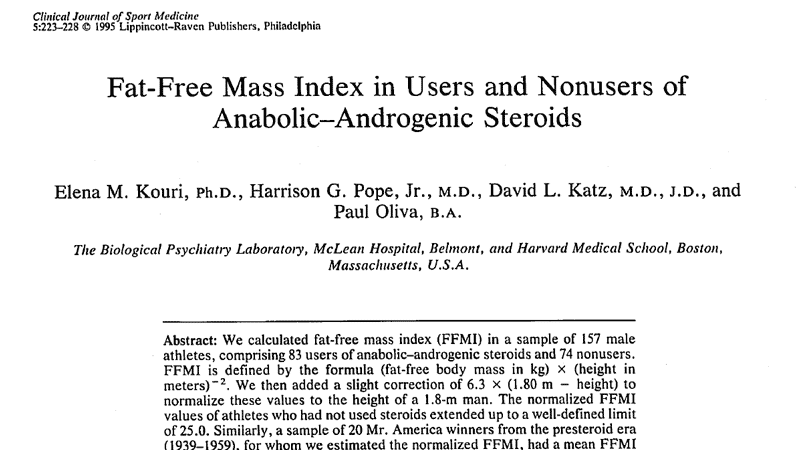
Fat-Free Mass Index
There is a debate among fitness bloggers whether the Fat-Free Mass Index (FFMI) can be used as an indicator of steroid use or not (and some accusations and “analyses” of individual fitness celebrities’ physiques). Most of these talks are based on the article of Kouri et al1, 19831. I would like to present the original findings here.
The authors took two groups of subjects – those who admittedly were steroid users (n=83) and those who weren’t (n=74) and calculated their FFMI. They found that the average FFMI among users was 24.8±2.2 and among non-users – 21.8±1.8. The difference was substantial and statistically significant, which allowed the authors to suggest using FFMI as a screening instrument for steroid use. The recommended cut-off score is 25.
I have plotted the theoretical distributions of FFMI for users and non-users and conducted a more in-depth analysis of the findings as well as the method of conditional probability of steroid use given that the FFMI is 25 or higher in one of my blogs and YouTube videos.
Link: https://www.ncbi.nlm.nih.gov/pubmed/7496846
Reference:
1. Kouri EM, Pope HG, Jr., Katz DL, Oliva P. Fat-free mass index in users and nonusers of anabolic-androgenic steroids. Clinical journal of sport medicine : official journal of the Canadian Academy of Sport Medicine. 1995;5(4):223-228.
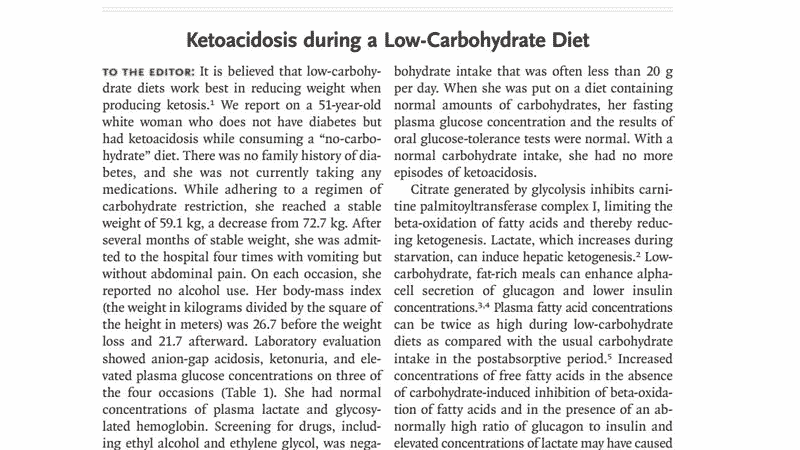
Ketosis vs. Ketoacidosis
I've dedicated a whole blog to everything related to ketosis and one of the things discussed there was whether an otherwise healthy person can get into a state of ketoacidosis while following a strict low-carbohydrate diet.
As I said there it is very unlikely that such thing would happen, but it nevertheless possible – there are some case reports where a person following a ketogenic diet enters a benign ketoacidosis. Here is one of these case reports – an article published in New England Journal of Medicine in 2006 by Drs. Shah and Isley1. Totally worth reading – a healthy woman followed a strict low-carbohydrate diet for several months and presented to the hospitals with signs and symptoms of ketoacidosis, confirmed by laboratory tests.
Link: https://www.nejm.org/doi/full/10.1056/NEJMc052709
Reference:
1. Shah P, Isley WL. Ketoacidosis during a Low-Carbohydrate Diet. 2006;354(1):97-98.

Change Psychology: The New Year’s Resolutions Study (2002)
Very nicely designed study by Dr.Norcross, a psychologist who was famous for multiple great studies, including the common factors research in psychotherapy. In this study he looked into the chances of accomplishing specific personal goals depending on the fact of making a form New Year’s resolution or not.
Researchers have randomly called 1288 telephone numbers in Scranton, PA in the last week of 1995. Out of the 434 individuals who responded to the call, 159 were making New Year’s resolutions (resolvers), and 123 have identified a behaviour they would like to change, but were not making a resolution (non-resolvers). In psychological terms, resolvers were in the action stage of change and non-resolvers were in the contemplation stage of change. Researchers interviewed these people, collected data on behaviours that they wanted to change and a number of other parameters that were necessary for statistical analyses. Majority of participants were women (72%) and almost all of them were Caucasian (99%). The three most common resolutions were weight loss (31%), exercise program (15%) and smoking cessation (12%). There was a significant difference between resolvers and non-resolvers – resolvers were more likely to list exercise program (22%) than non-resolvers (only 9%).
After this initial interview, researchers contacted their study subjects in 1, 2, 3 and 4 weeks and 3 and 6 months to see if they were successful in realization of their New Year’s resolutions. The analysis of the data showed that 71% of resolvers maintained their success in the first couple of weeks and almost half of them (46%) - up to 6 months, which was a pretty good result in my opinion. Especially, if we compare it to those who did not make their resolution – only half of them (51%) were successful in changing their behaviour in the first 1-2 weeks, and only 4% were successful at the 6-month time point.
You can see my detailed interpretation of the research findings in my blog on New Year’s resolutions as well as the analysis of the three studies (check them here and here) by Dr.Norcross’ team in the most recent blog "New Year’s Resolutions: An Update".
Link: https://www.ncbi.nlm.nih.gov/pubmed/11920693
Reference:
Norcross JC, Mrykalo MS, Blagys MD. Auld lang syne: success predictors, change processes, and self-reported outcomes of New Year's resolvers and nonresolvers. Journal of clinical psychology. 2002;58(4):397-405.
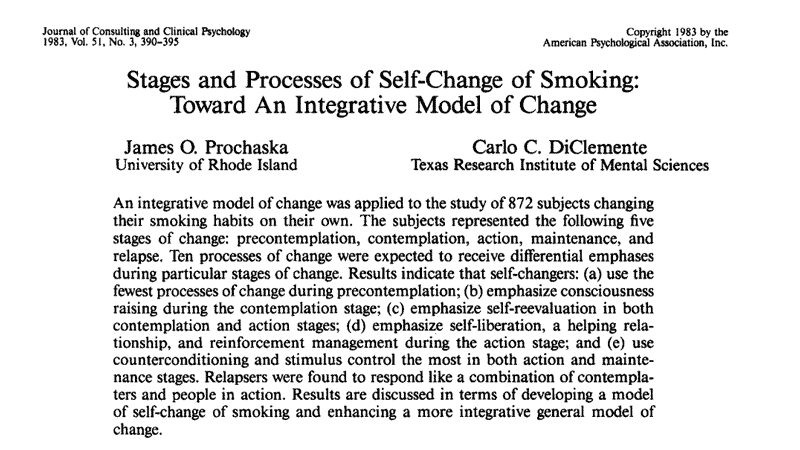
Classical Text: Stages of Change
The monumental publication by Prochaska and DiClemente, which laid a foundation for decades of research and clinical practice based on client's stage of behavior change also known as the Transtheoretical Model of Change. The article has both historical and clinical value as it outlines the shifts in perception of many clinical issues (including weight loss) and attitudes toward them. The model's stages are as follows:
- Precontemplation
- Contemplation
- Preparation
- Action
- Maintenance
- Relapse
Link: https://www.ncbi.nlm.nih.gov/pubmed/6863699
Reference:
- Prochaska JO, DiClemente CC. Stages and processes of self-change of smoking: toward an integrative model of change. Journal of consulting and clinical psychology. 1983;51(3):390-395.

Classical Text: S.M.A.R.T. goals
The original publication by George T.Doran, in which he outlines the S.M.A.R.T. goals - the rationale, the way they should be set, structured and completed. The article was published in 1981 and the original spelling for S.M.A.R.T. has evolved since then as I described in one of my blogs:
- S - Specific
- M - Measurable
- A - Assignable / Achievable
- R - Realistic / Relevant
- T - Time-related
Reference:
- Doran GT. There's a S.M.A.R.T. Way to Write Management's Goals and Objectives. Management Review. 1981;70:35-36.

Meta-Analysis: Diet vs. Exercise for Weight Loss
An excellent meta-analysis by Dr. James E. Clark1 published in the Journal of Diabetes & Metabolic Disorders in 2015. The meta-analysis summarizes 66 population-based studies and includes 162-studywise groups.
The main take-home points are as follows:
- Hypocaloric balance is essential for weight loss - the total body mass changes were most pronounced in the diet only group (ES*=1.24)
- Endurance training alone did not produce any significant changes in body mass
- Resistance training alone produced minimal changes in body mass (ES=0.25)
- Addition of exercise to diet resulted in less intense weight loss with effect sizes of 1.19, 1.06 and 0.57 for endurance training, resistance training and both added to the diet, respectively.
- At the same time the addition of exercise, especially resistance training helped to spare lean body mass and had a number of other positive metabolic and hormonal benefits.
*ES stands for effect size, shown only if statistically significant
Link: https://www.ncbi.nlm.nih.gov/pubmed/25973403
Reference:
- Clark JE. Diet, exercise or diet with exercise: comparing the effectiveness of treatment options for weight-loss and changes in fitness for adults (18-65 years old) who are overfat, or obese; systematic review and meta-analysis. Journal of Diabetes & Metabolic Disorders. 2015;14:31.
